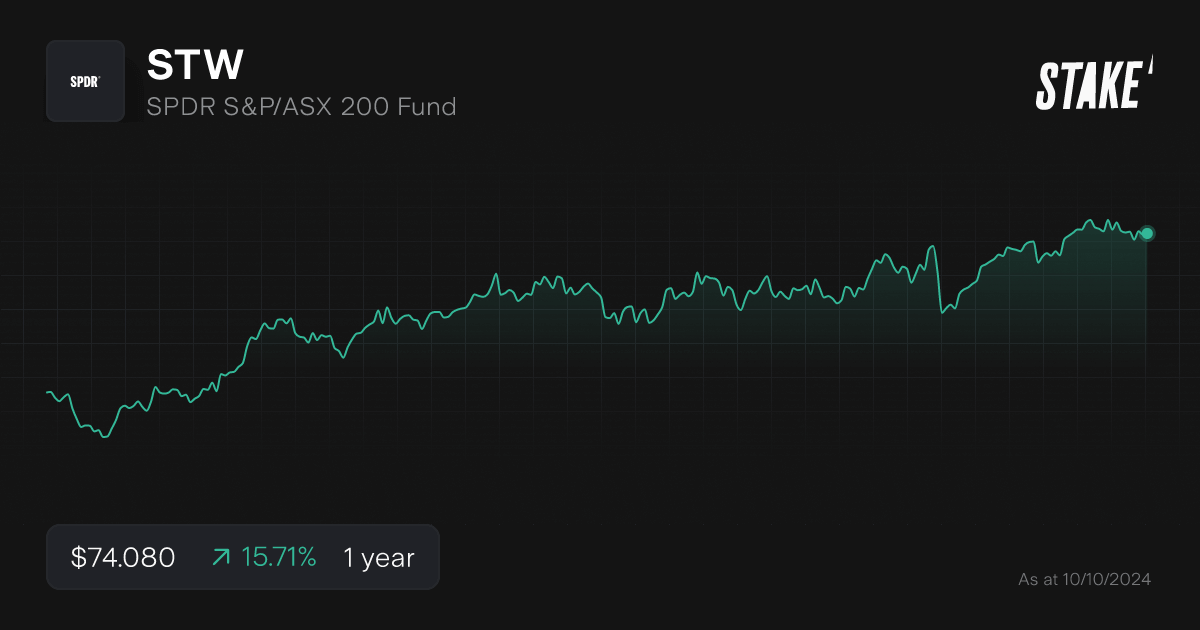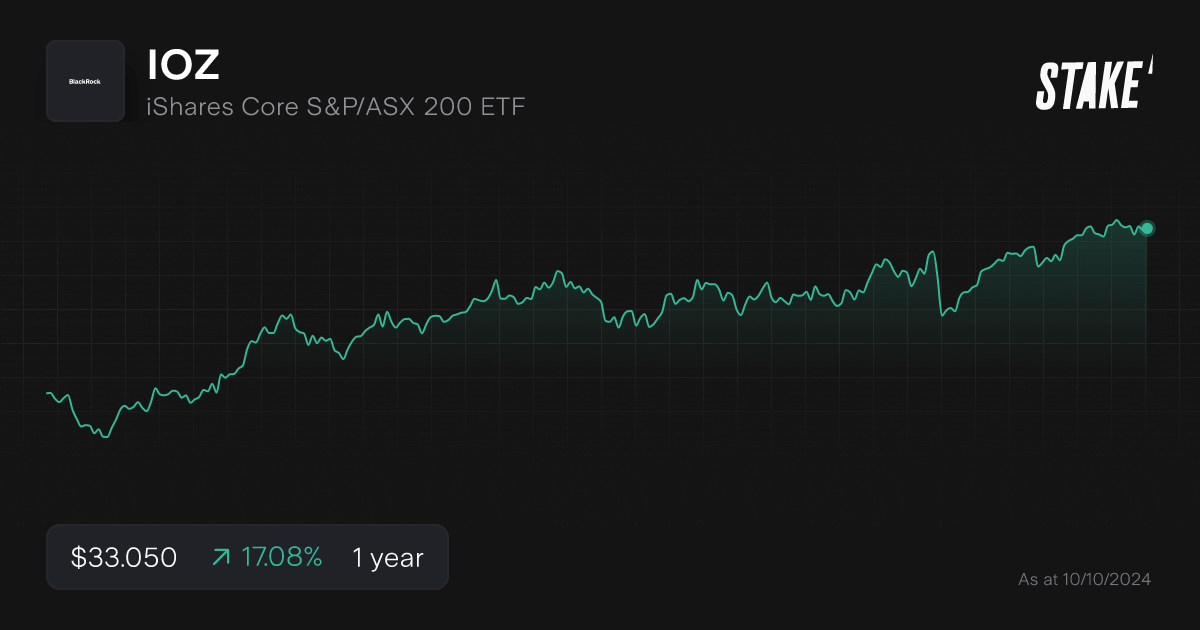
How to invest in the ASX 200 in 2024
The ASX 200 is an index containing the largest companies on the Australian Securities Exchange (ASX). Many Aussie investors look to the index to track market trends, it is widely considered to be the benchmark of Australian-listed companies.
To get exposure to the ASX 200, you could invest in individual companies on the index, or you could get simple exposure to all 200 companies through an exchange-traded fund (ETF) that tracks the performance of the entire index.
Check below to learn more and for steps on how to invest in the ASX 200.
What is the ASX 200?
The S&P/ASX 200 comprises the 200 largest companies by float-adjusted market capitalisation listed on the Australian Securities Exchange (ASX).
Launched in April 2000 by S&P Dow Jones Indices, this index is famed for being representative, liquid, and accessible – widely considered to be Australia's leading benchmark index.
Investors can access the S&P/ASX 200 through a variety of trading products, from individual company shares to ETFs and futures. The index reflects the Australian market's financial focus, heavily weighted with financial and material sectors.
How to invest in the ASX 200 in Australia
Investors have several options to gain exposure to the ASX 200 index. While some investors opt to invest in individual stocks on the index, a growing number of Aussies are looking to ETFs via an online share trading platform to gain simple exposure to the entire index with a single trade.
1. Open a stock investing account
To start investing in the ASX 200 through an ETF, you'll need to sign up with an investing platform. You’ll need to ensure this platform provides access to the Australian Securities Exchange (ASX) to find an ETF that tracks the index.
Get started with Stake
Sign up to Stake and join 750K investors accessing the ASX & Wall St all in one place.
2. Fund your account
After completing the onboarding process for your selected platform, you’ll need to fund your account to purchase shares. Each platform offers different funding methods, you can fund a Stake AUS account via bank transfer, credit/debit card, PayTo and Apple/Google Pay.
3. Search for an ETF that tracks the ASX 200
Once your funds are in your account, it’s time to find the stock or ETF that suits your individual goals. If you already know the security you’ll be buying, simply search for the name or ticker code.
If you’re still in your research phase, start discovering the various options you have access to, be sure to choose a security that aligns with your financial circumstances, budget, and risk appetite.
4. Place your first buy order
Once you’re ready to make your investment select the type of order and investment amount. You can choose to place a market, limit or stop order. Learn more about order types here.
5. Monitor your investment
Once your order has been filled, it’s wise to keep a close eye on your new investment and track its progress. Remember, there is always potential for stock price volatility and market fluctuations, which are natural considerations with any investment product.
If you’re looking to build your position over the long term, you could look into dollar cost averaging to spread out your risk and maintain consistency.

Which companies are in the ASX 200?
The ASX 200 includes some of the largest and most well-known Australian companies across a variety of sectors including financials, materials, healthcare, consumer discretionary and more.
What are the top 10 ASX 200 companies?
As of 30 September 2024, the top 10 companies by market cap on the ASX 200 index are:
Company Name | Ticker | Sector |
|---|---|---|
BHP Group Ltd | Materials | |
Commonwealth Bank of Australia | Financials | |
CSL Limited | Healthcare | |
National Australia Bank Ltd | Financials | |
Westpac Banking Corp | Financials | |
ANZ Group Holdings Ltd | Financials | |
Macquarie Group Ltd | Financials | |
Wesfarmers Ltd | Consumer Discretionary | |
Goodman Group | Real Estate | |
Rio Tinto Ltd | Materials |
Source: S&P Global
💡Related: Which are the best ASX bank stocks to buy?
What are the main sectors in the ASX 200 index?
As of 30 September 2024, this is how different sectors were represented across the index.
- Financials (31.8%)
- Materials (21.1%)
- Healthcare (9.4%)
- Consumer Discretionary (7.5%)
- Industrials (6.9%)
- Real Estate (6.9%)
- Energy (4.1%)
- Consumer Staples (3.9%)
- Communication Services (3.6%)
- Information Technology (3.2%)
- Utilities (1.4%)
Source: S&P Global
How is the ASX 200 calculated?
The ASX 200 utilises a market capitalisation-weighted formula, similar to other major indices, such as the S&P 500. Due to this, larger companies will have a greater impact on the index’s performance. The index is rebalanced each quarter in March, June, September and December.
How do companies get into the ASX 200?
For ASX-listed companies to make it into the ASX 200 they must first meet certain eligibility criteria. Here’s a breakdown of the eligibility factors:
- Listed on the Australian Securities Exchange: Only companies listed on the Australian Securities Exchange (ASX) can be considered. This includes primary and secondary listings.
- Domicile: Companies can be domiciled either domestically or internationally. Domestic companies are those incorporated in Australia. A company may be incorporated overseas and be listed exclusively on the ASX – or be traded heavily on the ASX.
- Eligible stock types: Only common and preferred equity stocks classified by the Global Industry Classification Standard (GICS) are eligible for consideration. Equity and Mortgage REITs are also eligible. However, hybrid stocks, listed investment companies (LICs), and listed investment trusts (LITs) are ineligible.
- Market capitalisation: Companies must meet the required market capitalisation thresholds to be considered for the ASX 200. This is based on the daily average market cap over a six-month period.
- Liquidity: Companies must demonstrate healthy trading activity and liquidity. This refers to the general ease with which an investor can trade a stock on the exchange. If liquidity drops too dramatically, the company is likely to be removed at the next index rebalance.
- Quoted shares issued: The number of shares considered should be based on the latest ASX-quoted data. For foreign entities, it accounts for the shares represented by CHESS Depositary Interests (CDIs) or those on the Australian register.
Meeting the above criteria is crucial for constituents of the ASX 200 to remain a reliable indicator and representation of the index.
What moves the ASX 200?
Various factors can influence the general market and by extension, the ASX 200. Here are a few common factors that can play a role in market fluctuation:
- Economic data
Economic indicators such as GDP growth, employment rates, inflation, and interest rates can have a sizable impact on the ASX 200. For instance, rising interest rates typically lead to higher borrowing costs, negatively impacting company profits and subsequently, their share prices.
- Earnings reports
Quarterly and annual earnings reports provide critical insight into a company's financial health. Positive earnings reports can lead to stock price increases, while disappointing results can cause declines. Given how the ASX 200 is weighted by market cap, a significant fluctuation for larger constituents of the index can affect performance significantly.
- Currency fluctuations
Currency fluctuations can also impact the performance of individual constituents or the ASX 200 as a whole.
- Commodity prices
Australia is a major commodities exporter. Fluctuations in global commodity prices can significantly impact constituents of the ASX 200, particularly resource-focused companies with a heavy weighting.
- Market sentiment
Geopolitical events, global economic outlook, and investor confidence can impact any financial market, including the ASX 200. It’s important to keep an eye on domestic and international news and consider the relevance of different stories in how they may influence general market sentiment.
- Sector-specific news
News or developments specific to heavily represented ASX 200 sectors – such as financials, materials and healthcare – can play a role in the index’s performance. Some examples include changes in policy, technological advancements or major partnership announcements.
Keeping up to date on these drivers helps investors understand potential movements in the ASX 200, allowing for more informed and strategic investment planning.
What is the best ASX 200 ETF?
Investing in the ASX 200 through an ETF allows Aussie investors to gain diverse exposure to the ASX 200 in a single trade. As every investor is different, the ‘best’ ETF is hard to define holistically, though there are a range of ASX 200 ETFs that are popular with a large cohort of Australian investors.
Betashares Australia 200 ETF ($A200)
Benchmark: Solactive Australia 200
Inception: 2018
Distribution frequency: Quarterly
Annual management fee: 0.04%
Objective: Tracks the 200 largest Australian-listed companies by market capitalisation. This Betashares ETF is often touted as having one of the lowest annual management fees, sitting at 0.04% per year.

SPDR S&P/ASX 200 ETF ($STW)
Benchmark: S&P/ASX 200 Index
Inception: 2001
Distribution frequency: Quarterly
Annual management fee: 0.05%
Objective: Aims to closely match the returns of the S&P/ASX 200 Index, before fees and expenses. Managed by State Street, this ETF provides investors with exposure to the 200 largest and most liquid publicly listed companies in Australia, effectively covering over 80% of the Australian equity market capitalisation.

iShares Core S&P/ASX 200 ETF ($IOZ)
Benchmark: S&P/ASX 200 Accumulation Index
Inception: 2010
Distribution frequency: Quarterly
Annual management fee: 0.05%
Objective: This iShares ETF seeks to track the performance of the S&P/ASX 200 Accumulation Index, which measures the performance of the 200 largest Australian securities listed on the ASX.

Do ASX 200 index funds pay dividends?
ETFs tracking the ASX 200 index will typically pay dividends/distributions to shareholders. Each fund will vary in its distribution frequency, yield and reinvestment options, so it’s best to check for specific details in the associated fact sheet of your prospective ETF.
✅ Looking for dividend-paying stocks on the ASX? Find out which are the best dividend stocks on the ASX.
What are the pros and cons of ASX 200 ETFs?
Understand the pros and cons of investing in ASX 200 ETFs before adding them to your portfolio.
Pros | Cons |
|---|---|
Diversification The ASX 200 comprises 200 constituents across 11 diverse sectors. Investing in the ASX 200 through an ETF can be an excellent method of simple and instant portfolio diversification. | Market risk As with any investable product, there is always potential for market volatility and price fluctuation. |
Low management fee Annual fees are typically lower for index-tracking funds, especially when compared to more actively managed funds that accrue higher annual management fees. | Limited customisation Index funds are not customisable and are therefore less flexible for investors seeking to pick and choose the positions they hold in their portfolio. |
Liquidity ETFs that track popular indexes are often highly liquid, meaning they are able to be bought and sold with less price volatility. | Sector concentration While there are 11 sectors represented in the ASX 200, financials and materials comprise over 50% of the index. This could hinder some investor’s goals of a more evenly diversified portfolio balance. |
Dividends ASX 200 ETFs will often pay distributions/dividends to shareholders. If reinvested, these payments could contribute to exponential position growth in the long term. | Management fees Unlike individual stocks, ETFs do come with annual management fees. |
Market representation Provides a good reflection of the overall Australian share market. | Dividend volatility Dividend yields can vary and are not guaranteed. |

Investing in the ASX 200 FAQs
The ASX 200 index has been quite stable over the last decade. See below for a breakdown of the total returns (data as of 30 September 2024):
- 2.97% - 1 month
- 7.79% - 3 months
- 12.33% - year to date
- 21.77% - 1 year (annualised)
- 8.45% - 3 years (annualised)
- 8.38% - 5 years (annualised)
- 8.93% - 10 years (annualised)
Source: S&P/ASX 200 Factsheet
One of the easiest ways to invest in the ASX 200 is via an exchange-traded fund.
You can do this by opening an account with an investing platform with access to the ASX. Plus, with a CHESS-sponsored platform like Stake, all your Australian holdings are held directly with the ASX under your name and HIN.
- Download the Stake app (available for iOS and Android) or head to our sign up page
- Open a Stake AUS account
- Make your first deposit and start exploring ETFs that track the ASX 200 index
- Place a buy order on the asset of your choice
Your first investment in any ASX-listed security must be at least $500 plus brokerage. This is known as the Minimum Marketable Parcel or MMP.
Once you hold $500+ of the asset, you can make subsequent orders from as little as $20 into the same position.
This article was edited by Robert Guy - Senior Markets Writer at Stake.
The information contained above does not constitute financial product advice nor a recommendation to invest in any of the securities listed. Past performance is not a reliable indicator of future performance. When you invest, your capital is at risk. You should consider your own investment objectives, financial situation and particular needs. The value of your investments can go down as well as up and you may receive back less than your original investment. As always, do your own research and consider seeking appropriate financial advice before investing.
Any advice provided by Stake is of general nature only and does not take into account your specific circumstances. Trading and volume data from the Stake investing platform is for reference purposes only, the investment choices of others may not be appropriate for your needs and is not a reliable indicator of performance.
$3 brokerage fee only applies to trades up to $30k in value (USD for Wall St trades and AUD for ASX trades). Please refer to hellostake.com/pricing for other fees that are applicable.


